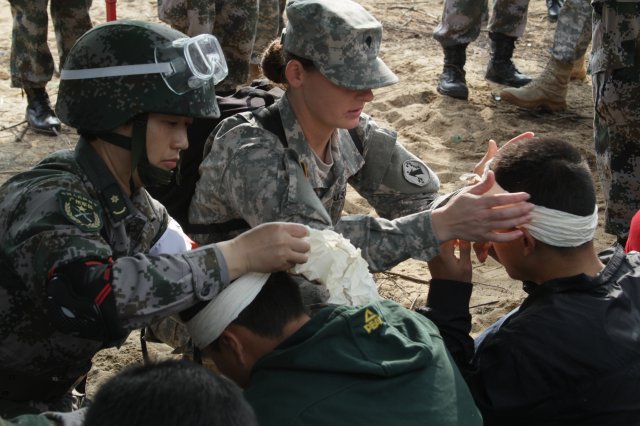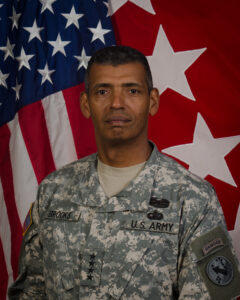
US and Chinese troops conduct a disaster relief exercise on Hainan Island in January, 2015
WASHINGTON: US and Chinese ships and aircraft are increasingly facing off in the disputed waters of the Pacific. On land, however, the US Army and its PLA counterparts are actually building a stronger relationship.
“While it’s very clear we have a competitive relationship also, especially in the air and maritime services, we have a cooperative relationship in the land domain,” Gen. Vincent Brooks told reporters this morning at a Defense Writers’ Group breakfast.
The Navy continues port visits, exercises, and other exchanges with the Chinese, but this is complicated by the Navy being the frontline service in the prickly South China Sea disputes. The Army, by contrast, doesn’t have to play any role but good cop, cooperating with its Chinese counterparts on such mutually beneficial missions as disaster relief. (Of course, if the Army created the anti-ship missile batteries urged by many in Congress, it might be less welcome in China).

Gen. Vincent Brooks
There are plenty of things Brooks is barred by law from discussing with the Chinese — primarily the National Defense Authorization Act of 2000 — and he made clear he steers away from those topics, as much as the Chinese would like to learn from US experience in, say, joint combat operations. But he is determined to deliver other messages.
“We’re known to have a lot of combat experience… and they want to learn from our experiences,” Brooks said. “[But] we always make sure we highlight the realities of combat, not the glories of combat.”
A veteran of Iraq, Brooks got to impart this lesson first-hand to a PLA sergeant during exercises on Hainan Island. The island is home to major air and naval bases that China patrols try to keep US spy planes and ships away from, sometimes using aggressive, even reckless tactics. But US ground troops posed no threat when they joined Chinese soldiers — about 200 soldiers from both nations all together — for a Humanitarian Assistance And Disaster (HADR) drill.
“I had lunch with a young woman who was a PLA soldier, a sergeant,” Brooks recalled. “I asked her, what made her join the PLA. [She said] ‘I wanted to serve my country, I wanted to protect my country.’ That’s great,” he said. “And,” she added, “I wanted to go to combat.”
That could have been an awkward moment — not just for Brooks, but for the other senior officer at the table, the commander of the PLA’s Guangzhou military region, who happened to have been wounded in action in Vietnam. (China fought Vietnam more recently than the US did. They also did not fare well).
“I kind of looked at him and said, ‘she has to be careful what’s she’s asking for,'” Brooks recounted. “And I just talked to her about the realities of combat… I can understand every warrior wants to be challenged and proven, we all feel that way, but be careful what you’re asking for. You’ve got to say goodbye to a lot of people you love.”
“This is why we have to have a relationship,” Brooks told reporters.
Of course, a single encounter with a single sergeant is probably not going to shift national policy. But the net effect of many such interactions over time can improve cooperation when policymakers are feeling friendly and reduce the chance of accidental clashes when policymakers are feeling prickly.
The US and Chinese militaries have a history of conducting exercises together, mainly in inoffensive and practical areas like disaster relief and search-and-rescue (including at sea, despite naval tensions). Such topics can even help bring together the region’s many mutually suspicious nations, with the US as a facilitator, Brooks said.
Before the Nepal earthquake, for example, militaries in the region saw the seismological writing on the wall. Knowing “we would one day one ourselves on a rubble pile in Nepal,” Brooks said, so the US was already discussing a future disaster relief operation with Nepal, India, and China. India and China happen to have a deeply ambivalent relationship of their own and even fought a war in 1962. For now, the US is conducting bilateral events separately with each nation, Brooks said, but he hopes to conduct trilateral US-China-India exercises in the future.
“Frankly, there is still a great deficit of trust in the Indo-Asia-Pacific region among the countries,” Brooks said. “Many of the countries in the region look to the United States as kind of an honest broker and a big brother.”
That includes Asians wanting the US to mentor problematic militaries, like that of Burma, which is slowly relinquishing the country to civilian rule. At one defense ministers’ meeting in Hawaii, Brooks recalled, “I literally had leaders from other militaries grabbing me by the land and leading me to the Burmese general who was there.”
Military-to-military relationships with China, Burma, or even an almost-ally like India can be fraught. But sometimes the US Army is well positioned to bridge some very troubled waters.
Army eyes TBI monitoring, wearable tech for soldiers in high-risk billets
“We are also looking at what additional personal protective equipment we can provide to our folks, especially instructors and others who are routinely exposed to blast pressure,” said Army Secretary Christine Wormuth.


























